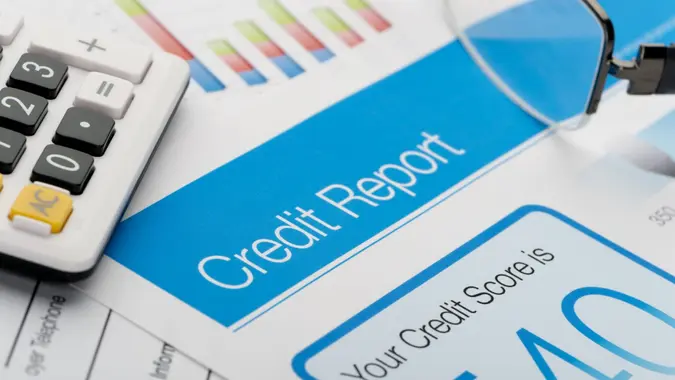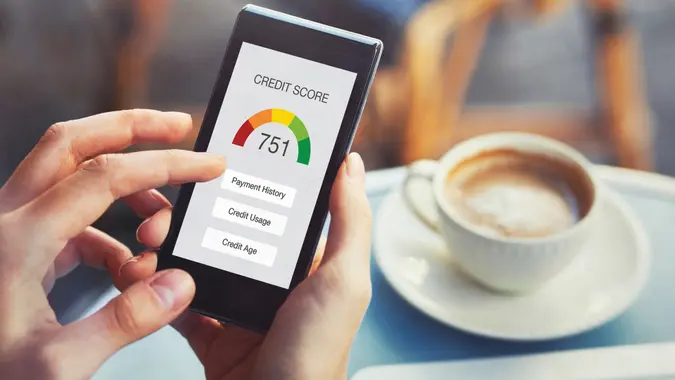How Is Credit Score Calculated and What Factors Matter Most?

Commitment to Our Readers
GOBankingRates' editorial team is committed to bringing you unbiased reviews and information. We use data-driven methodologies to evaluate financial products and services - our reviews and ratings are not influenced by advertisers. You can read more about our editorial guidelines and our products and services review methodology.

20 Years
Helping You Live Richer

Reviewed
by Experts

Trusted by
Millions of Readers
Credit scores are calculated based on five key factors that lenders use to assess risk, the most critical of which are your payment history and the amounts you owe. The others — age of credit, new credit and account blend — are less consequential, but still important to your score and overall credit health.
What Factors Are Used to Calculate Credit Score?
Credit scores are made up of five components — but they don’t account for an equal 20% each. Lenders care about some elements much more than others, and that is reflected in the uneven percentages each factor contributes.
- Payment history (35%): Do you pay your bills on time? A long history of on-time payments puts lenders at ease, but missing even a single one can tank your score by 100 points or more.
- Credit utilization (30%): How much of your available credit limit are you using? Lenders prefer a credit utilization ratio of under 30%, but a lower ratio is even better.
- Credit history length (15%): How long have you had credit accounts? Older accounts help your score because lenders prefer to see a long history of credit experience.
- Credit mix (10%): Do you have different types of credit? Lenders prefer a blend of accounts, like credit cards, auto loans and home loans.
- New credit inquiries (10%): How many times have you applied for new credit recently? Too many applications at once can lower your score because it could appear that you’re overextended or desperate.
How Do Credit Bureaus Calculate Credit Scores?
The three major credit bureaus — Experian, Equifax, and TransUnion — gather information from lenders on a regular basis. Lenders report details about their customers’ account activity each billing cycle, as well as data on loan and credit applications and any new accounts they approve.
The credit bureaus feed this data into various scoring models, including:
- FICO Score: The most widely used scoring model, which 90% of lenders rely on to assess applicant risk.
- VantageScore: Many free credit apps use this model.
Each model weighs the factors slightly differently, but payment history and credit utilization always matter the most.
What Counts as Good or Bad Credit?
Credit scores fall into one of five tiers, with each step up providing more access, better approval odds, lower rates and richer benefits.
- Tip: Even slight improvements can move you into a better range and save you money.
| Credit Score Range | Rating | What It Means |
|---|---|---|
| 300-579 | Poor | Hard to get approved, very high interest rates |
| 580-669 | Fair | Some approvals, still higher rates |
| 670-739 | Good | Approved for most loans at decent rates |
| 740-799 | Very good | Easy approvals and low rates |
| 800-850 | Excellent | Best rates and perks |
Why Do Credit Scores Change?
Your credit report updates when lenders report new data to the credit bureaus, like:
- Making a payment
- Paying off a balance
- Opening or closing an account
- Missing a payment
Most lenders report monthly, so your score can change frequently. However, updates don’t necessarily trigger a score change.
How to Check Your Credit Score for Free
You can get a free and reliable representation of your credit score, although it’s not always precisely what a lender might see, by using:
- Your bank’s or credit card’s mobile app
- Free apps like Credit Karma, which use the Vantage Score model
- Experian.com, which offers free FICO scores
Important: Checking your own score is a soft inquiry — it won’t lower your score.
How to Improve Your Credit Score
Get and keep your credit in tip-top shape by:
- Pay all bills on time, every time — even one late payment can cause real, lasting damage.
- Keep your credit card balances low relative to your open credit — under 30% of your credit limit is good, but shoot for 10% or less.
- Avoid applying for too much credit in a short period.
- Build your credit history by keeping old accounts open.
- Check your credit report for mistakes and dispute errors.
FAQ
- How is a credit score calculated if I have no credit history?
- Those with no credit history don’t have a credit score and are known informally as “credit invisibles” until they build a reportable credit history and are assigned a score, which takes at least six months.
- Do all lenders use the same formula to calculate credit score?
- No. Most use the FICO scoring model, but many use Vantage Score or others, depending on the lender and the type of loan.
- Can checking my own credit score lower it?
- No. It's a soft inquiry that doesn’t impact your score or show up on your report.
- What’s the fastest way to improve my credit score?
- Paying down your balances to widen your credit utilization ratio is the fastest way to improve your score, provided you’re paying your bills on time — nothing is more important than making all payments on time, every time.
 Written by
Written by  Edited by
Edited by 






















